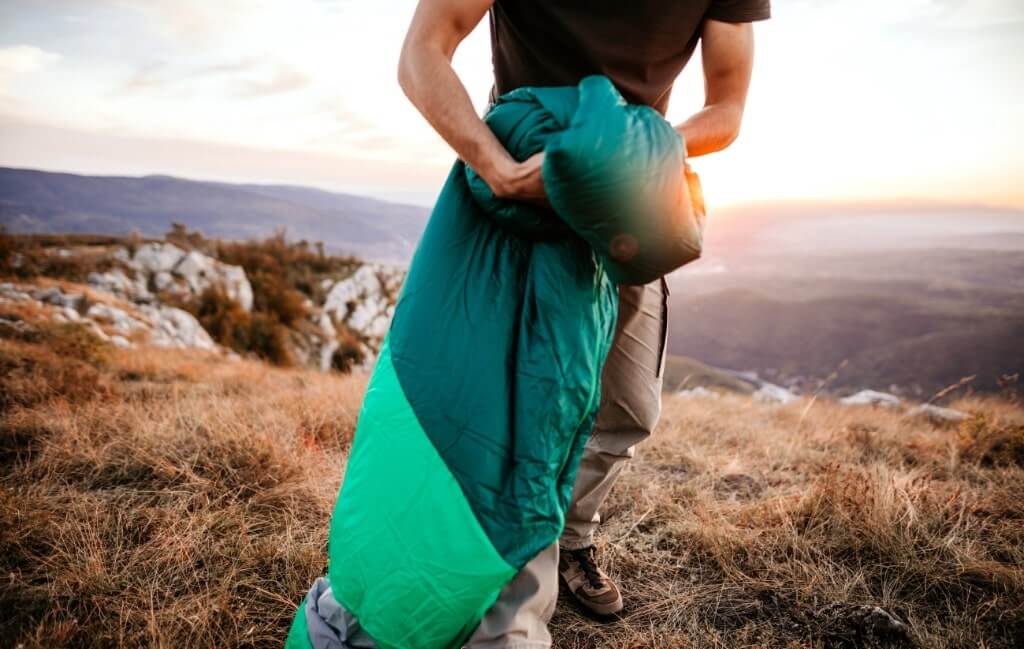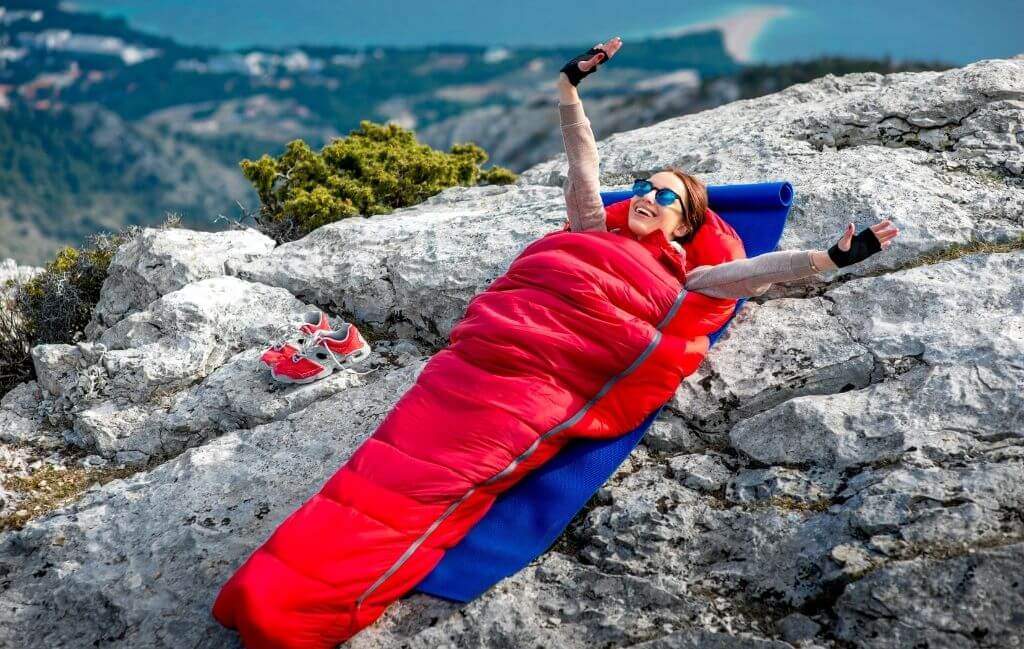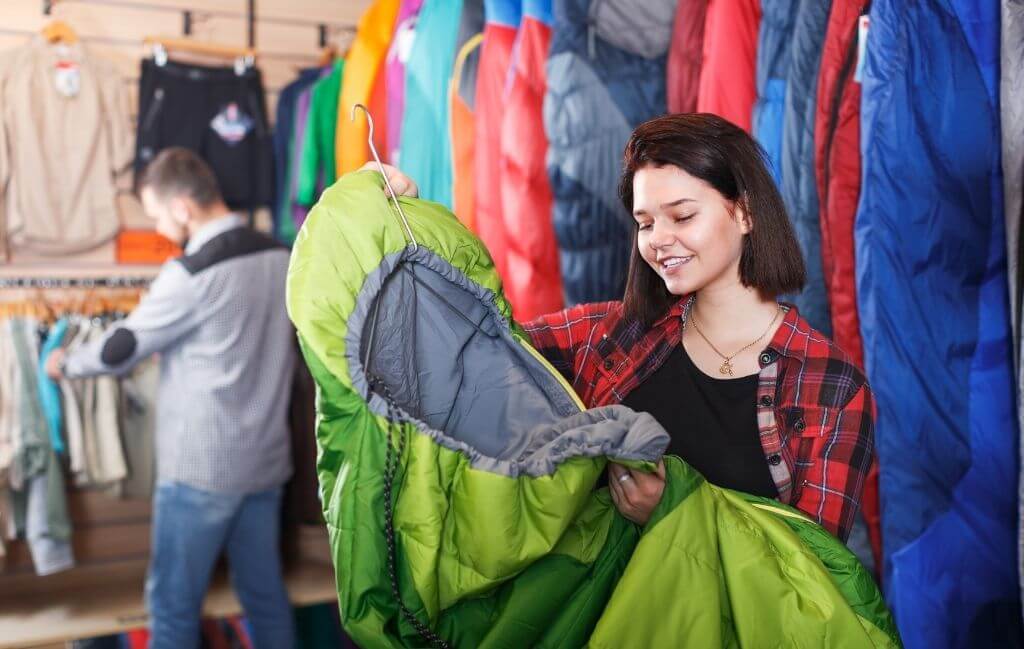What are the best sleeping bag materials? (Choosing Guide)

A sleeping bag is a piece of outdoor equipment used in camping, backpacking, and other activities which require spending the night away from home.
It is typically large enough to accommodate one person’s body length and designed to keep the sleeper warm by trapping air inside with an insulation material such as down or synthetic fibers.
A sleeping bag provides warmth for its weight relative to alternative methods of insulating oneself against cold temperatures. It also compacts more readily for storage than blankets or quilts.
What are the best materials for sleeping bags?
Sleeping bags are made of different materials such as down, synthetic and combination. Down sleeping bags are lighter in weight than regular sleeping bags because they have less filling material.
They also provide more warmth for their weight than the other two types of sleeping bags. However, they lose their insulation when wet. The synthetic sleeping bag is heavier and bulkier but it retains its insulating ability even when they get wet.
Down:
- Highly compressible;
- Lightweight;
- Very soft feel & comfy;
- Rises up very fast after compression;
- Loses loft if wet or damp;
- Expensive;
- Less durable than synthetic fibers;
- May be allergic to down.
- Slow to dry out due to high moisture vapor transmission rate (MVTR) than synthetics;
Synthetic:
- Less compressible than down;
- Heavier and bulkier than down bag;
- A bit heavier, but still lighter than regular bags;
- Dries quickly when wet or damp (good water repellency);
- Does not lose loft easily if wet;
- Cheaper than down;
- Durable (3–7 times the life span of a feather bag)
Down vs Synthetic, which is better?
Both down and synthetic sleeping bags have their own strengths and weaknesses. It all depends on what you are looking for in a sleeping bag. If you are an outdoor person, you will need both synthetic and down sleeping bags for different trips in different seasons.
Most of the campsites are not guarded and it is hard to keep your bags away from animals such as rats, mice, and so on.
Therefore, you should bring a rodent-resistant bag that is either made of or lined with a waterproof material but will add weight to your pack. In general, these bags cost around $60–$130 depending on their size, brand and material inside (pocket model).
Down sleeping bags are lighter in weight than regular sleeping bags because they have less filling material. They also provide more warmth for their weight than the other two types of sleeping bags.
However, they lose their insulation when wet. The synthetic sleeping bag is heavier and bulkier. But it retains its insulating ability even when they get wet If you get a synthetic sleeping bag, you will have to purchase a waterproof cover.
If you choose down sleeping bags, it would be best to go for the mummy-shaped model with an added collar because they tend to lose less insulating value when compressed at the bottom and provide better warmth in extremely cold conditions.
However, if you like to spread out as far as possible or use most of your backpack space just for clothes, by all means opt for a rectangular one. Make sure that your bag is light enough for carrying around but heavy enough to keep you warm even during winter nights. The insulation power of down bags is largely determined by the filled volume per oz (FL/OZ) number and eiderdown fill power can reach 800-900.
If you are looking for something less expensive and more durable, then synthetic sleeping bags will be the right choice.
The synthetic fibers inside these bags grab any moisture that comes into contact with them and keeps them away from your body while at the same time maintaining their insulation power.
However, if you are allergic to polyester or other material inside the bag, Synthetic sleeping bags can also dry out quickly when they get wet or damp due to their high MVTR (moisture vapor transmission rate).
To help reduce losing heat by perspiration, choose a mummy shaped sleeping bag with a water-resistant shell that keeps out most of the outside dampness.
If still getting cold at night during winter conditions, try using an insulated liner jacket inside your sleeping bag. This will help you retain your body heat inside the sleeping bag and it is more comfortable to sleep in.
It would be best for you if you choose a sleeping bag that offers comfort, warmth, lightweight (if not too heavy), durability at an affordable price!
How to choose a sleeping bag based on climate and temperature?

If you’re going out camping or backpacking, most people choose the type of bag depending on three main variables: the season, the proximity to your surroundings, and the weight you’re trying to carry.
Consider the following factors when deciding on a sleeping bag
The Season:
Down insulation is best for three seasons (spring/summer/fall) or warm temperatures. Synthetic insulation is better in extremely cold weather (or if you expect wet conditions).
You should buy an insulated sleeping bag liner for summer trips and longer trips because it will make your sleeping bag cooler. It is good for when it is hot, like in the summer. And you can use it all year round.
Proximity to Surroundings:
If you are backpacking into locations with limited water availability, down may not be your bag because the moisture from condensation in a tent can cause your bag to lose its insulation ability.
Synthetic fills tend to dry more quickly than down fill bags and have a lower moisture vapor transmission rate (MVTR).
Weight:
The weight of the sleeping bag is another major factor when deciding on which one you should purchase. Water-resistant synthetic fibers are heavier than regular synthetic fiber but they can resist condensation better or if your tent is wet from the rain.
If you’re backpacking into big mountains, it’s best to pack light sleeping bags as part of your gear so that you can carry other items in your backpack such as food, water, camping gear, and so on.
If you want a lighter down option, consider purchasing high-quality lightweight down like Euroold 750FX. This one has a very low-weight-to-warmth ratio, really strong and durable.
It’s compatible with all sleeping pad types and perfect for year-round use as it can regulate the temperature well, even in extremely cold weather.
On the other hand, if you are looking for a heavy-duty synthetic option down to -20°C then Euroold 3000 is an excellent choice for extreme temperatures.
What are the different types of sleeping bags?

There are four main types of sleeping bags which include down, synthetic, quilt or semi-quilt and hybrid.
1) Down Sleeping Bags:
Originally a hunting safety measure, down sleeping bags have been used for centuries in many forms all over the world.
These sleeping bags were filled with goose or duck feathers to keep the hunter warm while he was still waiting for his game to arrive at his shooting spot. The down fill keeps him warm by trapping body heat which prevents moisture from escaping through sweat produced during sleep.
Today there are several different varieties of down products and each one is lighter than the previous one due to high quality materials added into the design. Many outdoor enthusiasts prefer this kind of bag because it’s lightweight but extremely durable and comfortable.
2) Synthetic Sleeping Bags:
The synthetic fill is made out of polyester fibers and it’s considered a substitute for duck or goose down.
These fibers are created by twisting natural cellulose into strands, which are then woven together to make the insulation layer. The main advantage of this kind of bag is that it can withstand moisture better than down.
There are different kinds of synthetic bags that you can buy. There are light-weight “three-season” bags and heavy duty winter ones filled with hollow fibers and other high-tech materials designed to keep you warm even when it’s cold.
All four types of sleeping bags have their advantages and disadvantages depending on your personal needs and preferences. But remember that you should choose the one that is most suitable for your personal needs and type of trip.
3) Quilts/Semi-Quilts:
These are special kinds of bags where you can wrap yourself up or tuck yourself into a blanket-like piece during sleep. It doesn’t have insulation inside but allows you to customize your bedding by adding or removing layers.
The outer shell is usually made of a waterproof material where you can zip in the inner lining just like a sleeping bag.
These products are available in different sizes and shapes for all kinds of situations, including backpacking, climbing or mountaineering; and each one is highly versatile.
Semi quilts are another special type of sleeping bag that allows you to tuck yourself into a blanket-like piece but doesn’t have insulation inside.
They are very popular among mountaineers because they pack smaller than most bags while providing ample warmth and comfort even during winter trips or expeditions.
Most models out there have an integrated foot box that allows warmth to be concentrated around your feet to ensure that you stay warm all throughout the night.
4) Hybrid:
Hybrid bags are a combination of down and synthetic materials. This kind of sleeping bag is designed to provide both comfort and warmth while being lightweight at the same time.
They tend to weigh less than most other kinds of bags because they don’t use high-quality down, but still, provide much better insulation than regular synthetic ones do.
Last Few Words
Well, that sums up the most important features of different sleeping bags. A sleeping bag is a must-have item for any outdoor enthusiast because it’s not only lightweight and easy to carry; but also very comfortable.
Today there are many different kinds of products in the market with many options and designs. You can choose a product that is perfect for you.
My advice is not to buy a sleeping bag yet. First, compare all of the models. Second, think about the advantages and disadvantages of each model before you buy one.
Now that I have finished talking about what kind of sleeping bags there are, I hope you will know them better. You can use your sleeping bag for all sorts of things, not just camping or hiking. It just depends on what you need it for.
 John
JohnI am John, an outdoor gear staff expertise with tons of practical knowledge. My favorite hobby is moving around the world and adventurous in all the parts of the earth. I have been a worldwide traveler for over 10 years now with no sign of slowing down. I’m happily espoused and residing with my kids in California.
Junyuan BagsTen articles before and after
12 Best Backpacks for Engineering Students (2021)
How To Attach a Sleeping Bag To a Backpack: A Step-By-Step Guide | Backpack Guide USA
Backpack Guide to Choosing The Best Backpack 2019
15 Best Rolling Backpack for Nursing School (2021)
How To Carry Water While Skiing – Every Skiers missed That!
Best North Face Backpack for Diaper Bag (Updated 2021)
What Should Be in a Survival Backpack? A Complete List
Best Hunting Backpack Under 100 Bucks – Buyer's Guide 2021
The North Face Youth Recon Squash Backpack Review (2021)




 Mobile/What's App/Wechat
Mobile/What's App/Wechat E-Mail
E-Mail ADD
ADD




